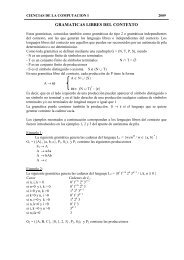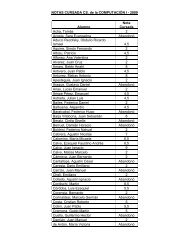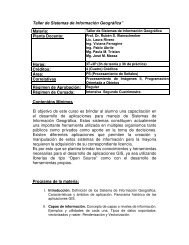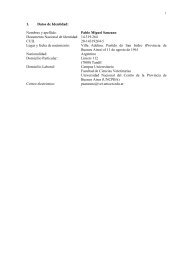Libro de Resúmenes / Book of Abstracts (Español/English)
Libro de Resúmenes / Book of Abstracts (Español/English)
Libro de Resúmenes / Book of Abstracts (Español/English)
Create successful ePaper yourself
Turn your PDF publications into a flip-book with our unique Google optimized e-Paper software.
Resumenes 66<br />
Suponemos que la función <strong>de</strong> crecimiento <strong>de</strong> la población <strong>de</strong> roedores<br />
es <strong>de</strong> tipo logístico, el cual incluye la <strong>de</strong>nso–<strong>de</strong>pen<strong>de</strong>ncia como principal<br />
forma <strong>de</strong> auto-regulación <strong>de</strong> la población (la cual dispone <strong>de</strong> un recurso<br />
alimenticio sin restricciones). La extracción <strong>de</strong> las presas por los<br />
<strong>de</strong>predadores (respuesta funcional) es <strong>de</strong> la forma Beddington-DeAngelis<br />
[5] que incorpora la respuesta hiperbólica con interferencia entre los<br />
<strong>de</strong>predadores.<br />
Por su parte la ecuación que <strong>de</strong>scribe el crecimiento <strong>de</strong> los<br />
<strong>de</strong>predadores también es <strong>de</strong> tipo logístico don<strong>de</strong> la capacidad <strong>de</strong> carga <strong>de</strong><br />
los <strong>de</strong>predadores es directamente proporcional a la <strong>de</strong>nsidad <strong>de</strong> las presas.<br />
Entonces el mo<strong>de</strong>lo propuesto es <strong>de</strong>l tipo Leslie [5] y es <strong>de</strong>scrito por el<br />
sistema <strong>de</strong> ecuaciones diferenciales:<br />
⎧dN<br />
⎛ N ⎞ qN<br />
⎪ = r⎜1−<br />
⎟N<br />
−<br />
P<br />
⎪ dt ⎝ K ⎠ V ( P)<br />
N + bP + a<br />
⎪<br />
X µ : ⎨<br />
⎪<br />
⎪dP<br />
⎛ P ⎞<br />
= s<br />
⎪ ⎜<br />
⎜1−<br />
⎟ P<br />
⎩ dt ⎝ n g(<br />
N,<br />
P)<br />
⎠<br />
7<br />
don<strong>de</strong> µ = ( r,<br />
K,<br />
q,<br />
b,<br />
a,<br />
s,<br />
n)<br />
∈ℜ<br />
+ y los parámetros tienen diferentes<br />
significados biológicos a<strong>de</strong>más la función g(N, P), indica la cantidad <strong>de</strong><br />
presas por <strong>de</strong>predador necesarias para sostener la permanencia <strong>de</strong> la<br />
población <strong>de</strong> <strong>de</strong>predadores, esto es:<br />
φ N<br />
g(<br />
X , P)<br />
=<br />
.<br />
V ( P)<br />
N + bP + c<br />
Demostramos que el (0,0) es punto atractor no hiperbólico y por lo<br />
tanto este mo<strong>de</strong>lo predice la extinción <strong>de</strong> ambas poblaciones.<br />
A predation mo<strong>de</strong>l consi<strong>de</strong>ring vulnerability on prey<br />
Since the works about population dynamics by Charles Elton, Alfred<br />
Lotka and Vito Volterra around the 20's last century, the theoretical<br />
continuous time predator-prey mo<strong>de</strong>ls are an important tool to un<strong>de</strong>rstand<br />
the complex oscillations on natural populations, and in particular, <strong>of</strong> small<br />
ro<strong>de</strong>nt populations.<br />
Density, persistence and stability <strong>of</strong> these populations are affected,<br />
mainly, by environmental fluctuations that <strong>de</strong>termine population size. An<br />
important factor that could influence ro<strong>de</strong>nt population size is the<br />
interrelation predator–prey, as well as environmental perturbation [2].<br />
Here we propose a theoretical continuous time mo<strong>de</strong>l based upon<br />
another mo<strong>de</strong>l constructed in [4], following Getz suggestions [1]. We are<br />
not consi<strong>de</strong>ring age or sex. Structure, variables and parameters are <strong>of</strong><br />
<strong>de</strong>terministic nature.<br />
An important aspect to be consi<strong>de</strong>red is the vulnerability <strong>of</strong> prey as<br />
function <strong>of</strong> predator presence in the environment hence we try to evaluate<br />
its ten<strong>de</strong>ncy for increasing or <strong>de</strong>creasing the stability <strong>of</strong> the system.<br />
The mo<strong>de</strong>l is constructed using the available information about the<br />
en<strong>de</strong>mic ro<strong>de</strong>nt <strong>of</strong> the central-northern region in Chile. This ro<strong>de</strong>nt is called<br />
leaf eared mouse (Phillotis darwini) and its specialist predator is the barn<br />
owl (Tyto alba) [2, 3].



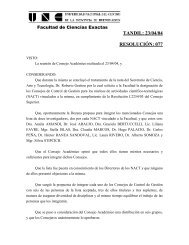
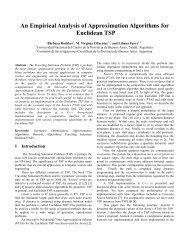
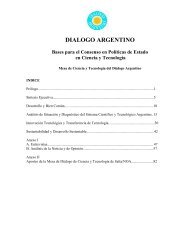
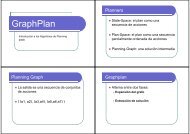
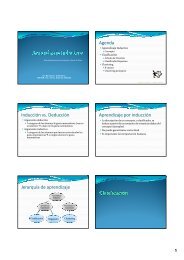
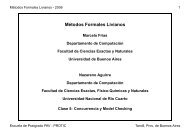
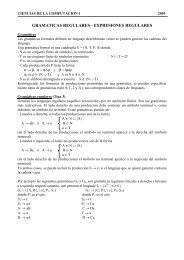

![Clase 13 [pdf]](https://img.yumpu.com/19616969/1/190x245/clase-13-pdf.jpg?quality=85)

